

Page 6 of 6


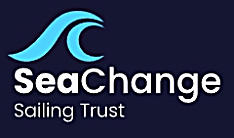
Sea-Change Sailing Trust, based in Maldon, Essex, are a small charity
operating a Thames sailing barge. Like many other sail training charities
around the UK, they take young people and vulnerable adults on life-skills-
building residential voyages, but there is more to this charity than meets the
eye:
Firstly, they have successfully raised the funds to build the first Thames
sailing barge built since 1930, a faithful replica of a steel Thames sailing
barge of the same name that was lost to a mine in WWII. The newly built
‘Blue Mermaid’ came into commission during the 2019 season, and unlike
other UK sail training vessels, she is engineless – with all her voyages
being carried out using just wind and tide alone. This has helped Sea-
Change Sailing Trust to win two environmental awards since the launch of
the barge.
Secondly, in addition to being able to carry passengers, Blue Mermaid has been granted a load line by the Maritime and
Coastguard Agency, enabling the sailing barge to carry up to 110 tonnes of bagged or 80 tonnes of palletised material. Operating
between Lowestoft in Suffolk and Sandwich in Kent, and all the tidal rivers in between, the charity aims to use the carrying of cargo
entirely under sail to add work experience and work-related training to their established youth and adult training programmes.
Richard Titchener, Executive Officer and skipper of Blue Mermaid, is keen to highlight that Blue Mermaid with a full hold will take
four lorries off the roads in East Anglia, and in the process provide skills-based training to people who in some cases, go on to find
employment in the marine sector.
Sea-Change Sailing Trust are now seeking cargo, and as an incentive to encourage local businesses to try shipping their cargo by
engineless Thames sailing barge, the charity will only be charging the 1931 freight rate as used by the original Blue Mermaid,
provided that other costs such as insurance, berthing and craneage are met. All possibilities considered – a full hold of 110 tonnes,
regular shipments, a one-off load of just one pallet, or even something more interesting to use as a PR exercise.
If you would like more information about sailing aboard, or sending a cargo with Blue Mermaid, please email the charity at
judy@seachangesailingtrust.org.uk
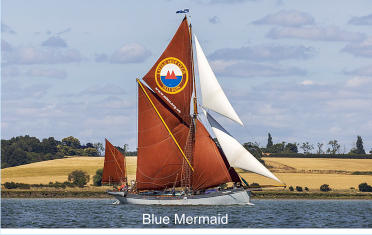

During summer 2023 Blue Mermaid delivered ten consignments of beer for
Maldon's Mighty Oak Brewery. It is rather daunting to think the last time we did
this was with Cambria in 2012! This time it is part of our sailcargo initiative and
is supported by the Essex Climate Impact Challenge Fund.
At Easter our first charter of the year was with three intrepid trainees. I say
intrepid because it was cold enough to see your breath at the breakfast table.
The brewery set us a challenge too, with five deliveries to be done between
Burnham and Harwich in five days. It meant really pushing on and using wind,
tide and forecast to best effect. Loading at Hythe Quay we towed away
lunchtime on Monday late morning and stopped a short while at Bradwell for
the bargeboat to deliver to the Yacht Club. The wind was southeast and gave
a good lee. Then it was up anchor and down river to lay inside Colne Point for
the Monday night, giving a good jumping off point for a trip over the Rays'n for
a lunchtime high water on Tuesday and two firkins for the Royal Burnham
Yacht Club, duly delivered. Up anchor again just before high water for a
couple of tacks before a glorious fetch to Harwich via the Spitway, arriving at
dusk to anchor on the Shelf.This was very convenient for landing two firkins for the New Bell next morning via the beach a few
yards from the pub. After tea and biscuits it was up anchor again for a foul tide fetch from the Naze to Mersea Quarters for the last
two deliveries. By now the wind was north-easterly with rain and you will appreciate how important the forecast had been for the
itinerary. First the sack barrow made light work of taking the firkin for Tollesbury Sailing Club up the waterside. The Coast Inn at
West Mersea had four and by now the sun shone and all was well.Friday saw the barge back at Heybridge ready for the rest of
what was a busy season of 27 charters. It was hoped to deliver Caribbean produce for Raybel CIC from Ramsgate to London as in
2021 but the De Gallant dropped off in France instead and delivery was by road from there. Efforts to find other customers for cargo
did not bear fruit though they continue.
And so it was good old Mighty Oak again who used us for the last two weeks of October to deliver to Harwich and Kent. Loading on
Monday manually at Heybridge for Harwich was much easier than expected and sixteen items were loaded in an hour on the
mooring at lunchtime by the bargeboat assisted by Stebbens’ crane. The wind was light from the east but due to build and next day
be a near gale until the back end of the week. It really was necessary to crack on and get to Harwich that night. The Shelf would be
an exposed anchorage so Ha’penny Pier was booked. The breeze that day peaked at force five ENE, a topsail breeze. With a
clean bottom (four scrubs this year!) the barge made her low water at Holland Haven and a tack off to near the Gunfleet gave a
fetch against the flood into Harwich. The excellent pier master confirmed on the phone at 1800 he would move a boat and put a
notice on the pontoon to reserve the western end. It subsequently transpired he monitored our progress and was a little confused
that the track turned back over the Shelf for twenty minutes while an outbound ship from Parkston Quay cleared the Stour and Oli
and Paul steeved up the bowsprit for coming alongside. Once sorted we rounded up off the pontoon, dropped the anchor and Oli
rowed the dolly line ashore. We were moored and tidy before midnight. Next day mooring lines were doubled due to the swell but
we were in the lee, and the three deliveries could be made safely. The Crown Post collected and we delivered to the New Bell and
the Alma, enjoying a splendid meal there afterwards.Wednesday the strong wind continued and we did a few jobs and some
sightseeing between showers, agreeing that the improving forecast for Thursday gave a window for getting back home. Mustering
before dawn, the boat was hove up, the bowsprit and bobstay set and the small jib sent two thirds of the way along the bowsprit on
the traveller because there was still plenty of wind. This was all done before leaving the pontoon because just round the corner
there was no lee until Bradwell. Slipping ropes at 0800 we were able to set the mainsail sheeted home before coming out of the lee
by the Navy Yard. The topsail was left stowed and stayed that way all day. Late again! The tide was flowing before the Cliff Foot
and it took over an hour to beat out of the harbour. This was repaid later as the wind dropped a notch and eastered just a touch
giving a fetch up the Wallet from the Medusa. By the Colne Bar there was two hours flood giving water to steer a straight line to
Bradwell.The jib came down in the lee of the trees at Stone. There is an eyelet for a retrieval line at the luff on the mitre seam, and
if set up with a line going to the clew it enables the sail to be "snuffed" and depowered when it is brought in before coming down.
When working aboard Mariquita, where the jib was shackled to the bowsprit and set flying, the retrieval line was a mystery and
never seemed to offer enough protection from flailing canvas, meaning most times the recovery was done in the lee of the staysail
with a bearaway. We now know from a chance conversation with Jim Lawrence how it is possible to rig the line right around the sail
providing perfect safety. But of course, a yacht on the Med circuit could scarcely have a line around the bunt of a jib, or could it?
Since a change of ownership Mariquita has been rigged with a stay and a hanked jib, so the issue and the tradition of a jib set flying
or smack fashion has been lost a second time. Ho hum.Bowsprit up and out of the way the wind direction gave a fetch to the quay
where we were to load beer for Kent after the weekend. Turning on the anchor and running a line to Centaur we were helped
alongside by her Thursday working party. Both Pudge and Centaur had their winter frames rigged, yet without covers. This is the
best way to look after a boat over the winter showing the quality of custodianship.Next day it rained all morning but improved for a
clean-up later ready for guests to accompany the beer on Monday. It was evident the berth was a poor one, even worse than the
previous year as the mud continues to grow. Being fourth berth out, or "fourth bottom" as it is sometimes called, has always been
prone to slipping off. In the past the mud was dredged away every few years by the landlord Maldon District Council and hence
really tight shore ropes meant a manageable gap. Certainly this was how it was when I worked on Xylonite until 2006. There were
more barges working from the quay then and mooring four out often happened. But this time no matter how tight the shore ropes,
there was a dangerous two-metre gap. Even if you could get aboard to rig a gangway the barge was at a ludicrously steep angle.
The gangway could not be left unattended or it would catch and do damage as she lifted. And our beer and guests were due when
the tide was out! What to do? Luckily, Thistle had a day trip Sunday and Sam Hicks kindly helped me move outside her on a better
berth on Sunday evening. Why Sam? Because Oli had an operation over the weekend on a broken tendon and has to avoid barges
for a bit. Luckily Shiner Wright was able to step in and join Monday evening for our departure on the morning tide Tuesday.Back to
beer! Moved and ready, Hilary, Judy and I welcomed our four trainees Ben, Tora, Oscar and Alex with mentor Anna aboard at 1400.
They donned hard hats and high vis vests and helped rig the displays and gangway for beer and guests to come shortly after. We
were honoured to welcome Councillor Peter Schwier, Essex Climate Czar, Councillor Flo Shaughnessy for the Maldon Town Mayor,
John Boyce from Mighty Oak and Nicky Spurr now at Essex County but remembered fondly as MDC's one time Estuary Officer.
And there was the media team from ECC to capture the event. Thirteen firkins of ale arrived and were moved across before an
adjournment for tea and cake below followed by loading and securing them. And then it rained and blew from the east. It was not
an evening to be towing away and beating to windward downriver in the rain when next day promised better conditions. Ahead of
the game Jim Dines brought the tug alongside in the evening ready for a smart getaway.Tuesday dawned wet but improving.
Dropping the tow at Hillypool the light airs were all over the compass. First northwest, then north and veering round to west by the
time we reached Osea. Shiner and the team made light work of dropping the bowsprit and setting the working jib hanked to the
stay. With a nice breeze and sunshine the miles dropped astern and we were at the Spitway at half ebb. Here the sheets were
hauled and the barge brought on the wind for the long plug to windward to Kent. By now the wind was southwest, but the tide being
neaps, was strong enough for us to make well over it. Sailing well, often at over seven knots, and passing over the wreck of the
original Blue Mermaid on the slope of the Middle Sand, we made low water at the Southwest Barrow. There was a big gap in the
shipping and the wind was forecast to come southerly, so a long board was made to the Kent side near the Mid Cant beacon.
Dinner was eaten under way. By now it was coming dark so lights were shipped and the crew thought about where we would get to
by high water at 2200. I told Medway VTS we hoped but were unsure it would be the Bullnose at Chatham. It was not to be as the
wind slowly died away. We would do better than Stangate Creek but short of Chatham. It turned out to be just above Beesness in
Long Reach about four miles from our destination of GPS Upnor the next morning.Wednesday and on deck at first light. Bowsprit
steeved up as the rain cleared and a nice easterly took us to Upnor well before high water to find a friendly orange-suited welcome
on the quay. A space had been cleared for us under the crane and the tug GPS Ionia, about to depart from the upper pontoon, gave
us a handy turn and many hands ran the dolly line to our berth. It was evident in this process the lack of an engine was unusual
here, unsurprising in a regime of tugs and towing. The staff could not have been more helpful, bringing in the crane driver specially
and taking the beer to the King's Arms on their truck. The landlord of the Elephant in Faversham collected his beer from there. It
was particularly pleasing to see a couple of pallets craned out of the hold, the first time we had discharged on a commercial quay. It
is our intention it will not be the last.
All this cargo delivery is not necessarily child-centred. Ok, it
gives a reason to make a passage and that is the
philosophy. It puts our trainees in the commercial world and
gives a sense of real achievement. All these are sound sail
training ideals. But it does not lend itself easily to beaches,
swimming, dinghy sailing and more. So that afternoon Anna
took the team to Upnor Castle and this was a hit. They
returned with a Blue Mermaid doll. And after the landlord of
the King’s Arms took me shopping some distance away in
his sports car, we visited his cellar to see the beer racked
and ate from his menu above.High water next day was after
eleven. We had a long way to go but expected a fair wind
after Gillingham. It was not the fantastic SW 5 or 6 forecast
several days before, but was at least SE becoming SW 2 to 4. We needed to leave on the flood to sheer clear of the berth and the
two large lighters moored ahead of us. The evening before departure the wind was forecast to be southerly being on the quarter. It
might even be SW giving an easy departure and a fetch until in clear air in Cookham Reach. On the day, of course, all was
different. The wind was SE, onto the pier. This meant the first mile was to windward with a foul tide in a narrow width of river
between burgeoning moorings, so we planned to leave at 1030 and hit slack water soon after. Better still, we were offered a pluck
off the berth. Fantastic! I asked about a pluck round the corner too and was prepared to pay for it. An hour before we wanted to go
the friendly tug skipper arrived to say he had to drive to a job in Ramsgate urgently and if we wanted his help running a line to the
lighters we would need to go now. So we did, but knowing the barge would struggle to tack safely in the short tacks and foul tide,
Shiner was promoted to Chief Engineer and warmed up the outboard on the quarter while the line was led. The crew tailed on it
from amidships and the tide behind the leeboard shot the barge to windward across the river. It took a dozen rapid tacks but with a
little help from astern the barge did not falter and we could dispense with the outboard at Giĺlingham just as the wind veered and
gave us a fetch. The locks at the Bullnose looked suspiciously quiet. Apparently, the owner wants to develop the land around the
Chatham basins despite local opposition. I can remember meeting warships in Gillingham Reach in the 80s. It looks like only
Scotline and dredgers continue to work the upper reaches now and long may they. Given that the wind was fair, the bowsprit stayed
up and the jibstay run down to set the staysail, making low water at the Whitaker and coming to anchor at dusk at Osea for a final
dinner aboard. Next morning it was only two miles to the mooring but, after getting under way and tacking round, the gentle
southerly died leaving a mirror calm and the passage ended as it had begun with the small outboard taking us to the mooring. In
the past using hired vessels with engines we have offset carbon with Yacht Carbon Offset and maybe we need to do the same now
for Blue Mermaid and include the tiny amounts of fossil fuels used for cooking and heating as well. We never have claimed to be
zero carbon, only ultralow. Zero means wearing stout natural fibre undergarments and consigning most of our wardrobe including
modern wet weather gear to the scrapheap. I once had a real old oil skin coat given me by George Francis, a neighbour in
Brightlingsea and ex-foreman of the Colchester Oyster Fishery. I was told it was him as a young man photographed by Douglas
Went up the mast of the Ellen on the hard fitting out for stowboating. It is reproduced in one of Hervey Benham’s books. The oilskin
was mighty heavy but certainly looked the part. It was eventually scrapped when I got fed up with sewing up the growing number of
holes.End of season. After catching up ashore and some time off, the refit will start. The five yearly survey will happen in the spring.
The new barge is not new anymore!
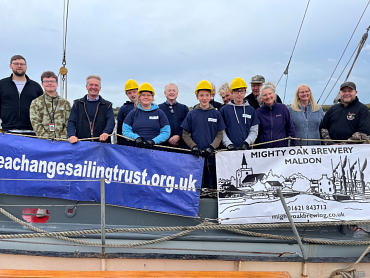
Beer to Bradwell
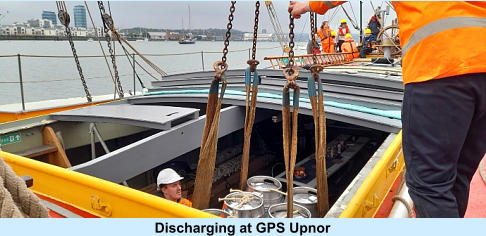
Merchant Navy Association Boat Club
(Affiliated to the Merchant Navy Association National Charity)
FEATURED ARTICLES



Page 6 of 6

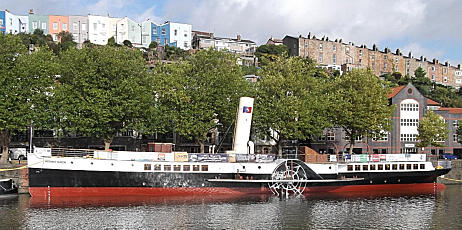
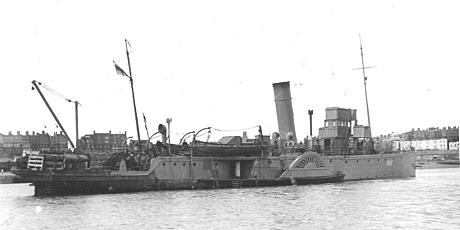
As a Minesweeper in 1940
Moored at Gillingham Pier
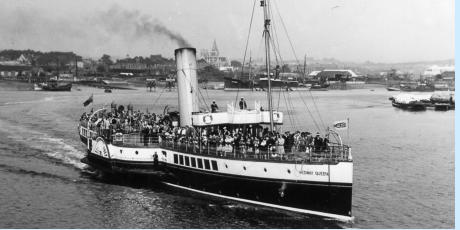
As a Pleasure Craft in the 1930’s
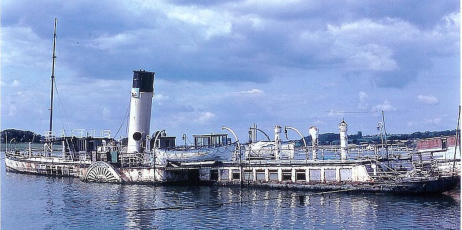
Abandoned in the Isle of Wight in the 1980’s
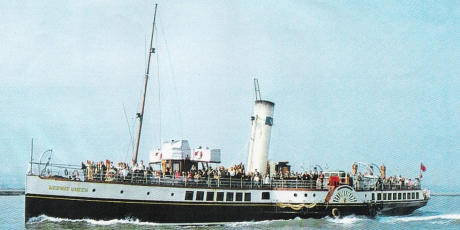
Post War Return to Service
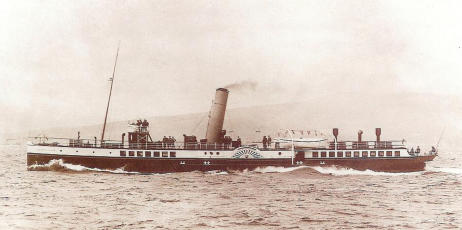
Speed Trials in 1924
In the early 1960s paddle steamers were struggling to compete with newer-type vessels and the Medway Queen made her last
voyage to Southend on 9th September 1963.
After several attempts at preservation had failed, the ship was towed by the tug Dhulia to the Isle of Wight to become a restaurant
and nightclub. The Medway Queen Club was popular for wedding receptions and the on-board restaurant was a favourite with
locals and holidaymakers alike. In the evenings it became a night club with disco and live music.
Following the closure of the Medway Queen Club in 1974, the ship suffered hull damage and became semi-submerged in the river
Medina. In 1984 she was moved back to the River Medway on a pontoon. The current Medway Queen Preservation Society was
formed in 1985 to support this endeavour and later became owners of this historic vessel.
After many years of frustration and hard work the society secured the backing of the Heritage Lottery Fund and, later, the
European Regional Development Fund to rebuild the ships hull and establish a base and workshop at Gillingham Pier. The hull
rebuild was undertaken in Bristol and completed in late 2013.
PS Medway Queen was ordered in 1923 and entered service on the Strood-Chatham-Southend-Herne Bay route the following
year. With occasional excursions elsewhere she served on the same route until the beginning of the Second World War
Medway Queen was requisitioned for the Royal Navy in 1939 and converted for mine-sweeping. In 1940 HMS Medway Queen
joined the 10th Mine-sweeping Flotilla based in Dover and remained an active minesweeper until late 1943. In April 1944 she was
recommissioned and attached to the mine-sweeping training base at Granton.
The 10th Flotilla played a key part in 'Operation Dynamo' in May-June 1940. Medway Queen and her crew made seven return
trips to Dunkirk to bring the men home. The ship's crew estimated that they evacuated 7,000 men while shooting down three Axis
aircraft. The Medway Queen was designed and built for estuary operations only and was therefore not licensed to go "deep sea"
or across the channel so her role in WW2 involving multiple channel crossings was even more remarkable.
In 1946/7 she was refitted and returned to civilian use.
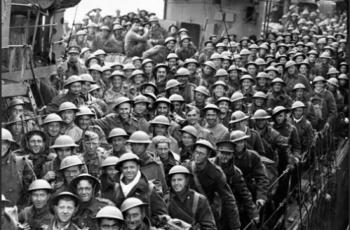
Rescued Troops
Medway Queen was towed back home and is now moored at Gillingham Pier where she can be visited.
